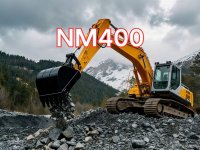

NM400
NM400 is a high-strength wear-resistant steel plate. Its designation follows the internationally recognized naming system for wear-resistant steels and primarily complies with the performance requirements specified in the European standard EN 13242:2022 "Aggregates for Unbound and Hydraulically Bound Mixtures for Construction Works – Specifications". It is also widely referenced against national industry standards, such as China's GB/T 24186-2019 "High-Strength Wear-Resistant Steel Plates for Construction Machinery". This standard clearly defines the chemical composition, mechanical properties, hardness, and testing methods for NM-series wear-resistant steels and serves as a widely accepted technical basis for production and trade globally. As a medium-to-high hardness grade within the wear-resistant steel family, NM400 delivers outstanding performance in resisting abrasive wear under severe operating conditions.
The designation "NM400" has a clear meaning:
"NM" stands for "Nai Mo", the pronunciation of the Chinese word for wear resistance, and has become a universal international code for high-strength low-alloy wear-resistant steels, distinguishing them from ordinary structural steels.
"400" indicates the average Brinell hardness of the steel after quenching and tempering heat treatment is 400 HBW. According to relevant standards (e.g., EN ISO 6506-1), its actual hardness typically ranges from 370 to 430 HBW. This hardness level is significantly higher than that of NM360 (330–390 HBW) and belongs to the medium-to-high wear-resistance category, effectively resisting severe abrasive wear, while placing higher demands on the material’s toughness, weldability, and processability.
The primary application of NM400 steel plate is in manufacturing critical components operating in extreme wear environments, especially where resistance to intense abrasive wear, impact wear, and gouging wear is required. Typical applications include:
Mining and Quarry Equipment: Liners, jaw plates, impact plates, cone crusher mantles, screens, and feeder troughs that are in constant contact with hard ores and rock.
Construction Machinery: Bucket teeth, base plates, side cutters, track guard plates, and loader cutting edges—commonly worn parts.
Dump Trucks and Haulage Vehicles: Floor, side, and tailgate panels for heavy-duty dump trucks and mining trucks used to transport highly abrasive materials such as iron ore, granite, and construction debris.
Cement and Building Materials Industry: Mill liners, classifier vanes, pipeline elbows, and fan impellers subjected to high-speed particle erosion.
Power and Metallurgical Industries: Chutes in coal handling systems, ash hoppers in dust collectors, and internal linings for sintering plant equipment.
Its main characteristics include:
Extremely High Surface Hardness and Wear Resistance: With a hardness of 400 HBW, it offers excellent resistance to abrasive wear, extending service life several times longer than ordinary steel.
Good Overall Mechanical Properties: Through precise alloy design and quenching & tempering processes, NM400 maintains sufficient toughness while achieving high hardness, preventing brittle fracture under impact loads.
Controlled Weldability: Although more challenging to weld than mild steel, reliable welding can be achieved by preheating (typically 150–200°C), using specialized wear-resistant electrodes or flux-cored wires, and controlling interpass temperature, enabling repair and assembly.
Limited Cold Formability: Due to its high hardness, cold forming capability is restricted. Bending should be performed within the recommended minimum bending radius, and repeated bending is not advised.
High Cost-Effectiveness: Compared to higher-hardness grades like NM450/NM500, NM400 provides adequate service life in most medium-to-severe wear conditions at a relatively lower cost, offering outstanding overall value.
Therefore, NM400 is a high-performance, widely used wear-resistant steel, making it an ideal material for combating severe wear challenges.

Ultrasonic Testing (UT)
A key non-destructive testing technique that uses high-frequency sound waves to detect internal flaws in steel plates. The probe emits sound waves, which reflect when encountering defects such as cracks or inclusions. The receiver captures the echoes, enabling precise determination of defect location and size. With high sensitivity, strong penetration, and fast inspection speed, UT effectively ensures internal quality, widely used in the production of heavy plates, pressure vessel plates, and other high-end products to guarantee safety and reliability.

Magnetic Particle Testing (MT)
A common surface inspection method that magnetizes the workpiece, causing leakage magnetic fields at surface or near-surface defects like cracks or inclusions, which attract magnetic particles to form visible indications. Simple to operate and highly sensitive, MT is suitable for rapid inspection of surface and near-surface flaws in ferromagnetic materials, widely used for online or offline inspection of plate edges, ends, and welds, ensuring product quality and safety.

Penetrant Testing (PT)
A non-destructive method for detecting surface-breaking flaws. A penetrant liquid is applied to the cleaned steel surface, allowing it to seep into defects such as cracks or pores. After removing excess penetrant, a developer is applied, causing the trapped penetrant to bleed out and form visible indications. Simple and cost-effective, PT is suitable for inspecting surface defects in various non-porous materials, commonly used for welds, castings, and complex components, effectively ensuring surface quality of steel plates.








